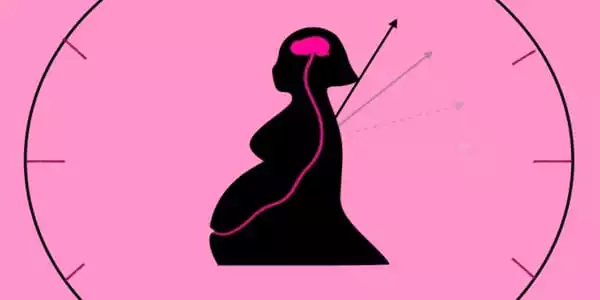Anxiety and depression can reduce mothers’ quality of life during the peripartum period (the three months before and after giving birth). A recent study linked peripartum sadness and anxiety to sleep and biological rhythm alterations in late pregnancy and postpartum.
Changes in the strength of the circadian rhythms, the average amount of activity during nighttime rest, and fragmented sleep were identified as characteristics connected to depression and anxiety by researchers. All three were highly associated with increased depressed and anxious symptoms.
Researchers recruited 100 women, following 73 of them from the beginning of the third trimester to three months postpartum. They used a number of instruments, including questionnaires, actigraphs (wearable sleep monitors), laboratory assays, and other approaches, to examine subjective and objective measurements of sleep, biological cycles, melatonin levels, and light exposure.
According to a new study, a combination of characteristics comprising sleep and biological rhythm variables are closely connected with the intensity of depressed and anxious symptoms from the third trimester of pregnancy through the third postpartum month.
Our findings underline the importance of maintaining the internal biological clock throughout the peripartum period to preserve healthy mood and minimize worry. “Given the findings, further efforts should be undertaken to standardize evidence-based therapies targeting key biological rhythmic characteristics identified by our team, either as treatment or preventative techniques.
Professor Benicio Frey
The three-month interval preceding and following childbirth is particularly hazardous to women’s mental health. During the peripartum period, it is estimated that 15% to 18% of women feel anxiety and 7% to 13% experience depression. Furthermore, nearly 10% of women have clinical levels of comorbid anxiety and depression during this time.
Researchers discovered multiple characteristics connected to melancholy and anxiety in the largest observational study to date on changes in sleep and biological rhythms during the peripartum period. Changes in the circadian quotient (the strength of the circadian rhythms), the average amount of activity during nighttime rest, and the degree of fragmentation of nighttime rest were all substantially connected to increased depressive and anxiety symptoms.
“Our findings underline the importance of maintaining the internal biological clock throughout the peripartum period to preserve healthy mood and minimize worry,” said Benicio Frey, senior author of the study and professor of psychiatry and behavioral neurosciences at McMaster University.

“In light of our findings, future efforts should be made to standardize evidence-based therapies targeting specific biological rhythm characteristics identified by our research, either as therapy or prevention techniques.”
The study was carried out by Frey and his research team from the Women’s Health Concerns Clinic at St. Joseph’s Healthcare Hamilton. This clinic specializes in peripartum, premenstrual, and perimenopausal psychiatric illnesses.
Researchers recruited 100 women, following 73 of them from the beginning of the third trimester to three months postpartum. They used a number of instruments, including questionnaires, actigraphs (wearable sleep monitors), laboratory assays, and other approaches, to examine subjective and objective measurements of sleep, biological cycles, melatonin levels, and light exposure.
Surprisingly, the data suggest that certain biological rhythm characteristics may be relevant in the development of depressive symptoms at various stages in the peripartum timeline. Higher fragmentation of nocturnal slumber, for example, was connected to a reduction in depressive symptoms six to twelve weeks postpartum – a period that tends to correspond with a higher risk of developing postpartum depression.
Overall, the data imply that subjective biological rhythm disruptions are linked to higher depressed and anxious symptoms peripartum, which is consistent with findings that objective biological rhythm disruptions are linked to similar symptoms. Sleep pattern abnormalities were also identified in the study population, however biological rhythm variations were more substantially associated with depressed and anxious symptoms.
“Given the findings,” the researcher added, “further efforts should be undertaken to standardize evidence-based therapies targeting key biological rhythmic characteristics identified by our team, either as treatment or preventative techniques.”
According to Frey, the data suggest that particular biological rhythm characteristics may influence depressed symptoms at different stages in the peripartum timeline. Higher fragmentation of nighttime rest, for example, was linked to a decrease in depressive symptoms six to twelve weeks postpartum, a period that tends to coincide with a higher risk of developing postpartum depression, implying that mothers with fewer symptoms of depression were more responsive to the needs of the overnight baby.















